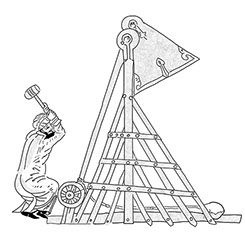

Accursed Tower
Prologue: The Accursed Tower
In the spring of 1291, the largest army that Islam had ever assembled against the crusaders in the Holy Land was moving towards the city of Acre. It was, by all accounts, an extraordinary spectacle – an immense concourse of men and animals, tents, baggage and supplies, all converging on Christendom’s last foothold. The aim was to deliver a knock-out blow.
Forces had been drawn from across the Middle East; from Egypt 500 miles to the south, from Lebanon and Syria as far north as the banks of the Euphrates, from the great cities of Cairo, Damascus, and Aleppo: a gathering of all the regions’ military resources. The elite troops were enslaved Turkish-speaking warriors from beyond the Black Sea, and the army included not only cavalry, infantry, and specialist supply corps, but enthusiastic volunteers, mullahs and dervishes. The campaign had inspired a popular fervour for holy war – and a less pious one for booty.
Visible in this panorama a vast array of outfits, devices and armour: lordly emirs in white turbans; foot soldiers in conical metal helmets, chain mail, and leather scale tunics; cavalry armed with short bows, their animals covered in colourful cloths and saddles embroidered with heraldic insignia; camel-mounted musicians playing kettledrums, horns and cymbals; fluttering yellow banners and weapons of all kinds: maces, javelins, spears, swords, siege crossbows, carved stone balls, naphtha for the manufacture of Greek fire, and clay grenades. Oxen strained to haul carts laden with timber from trees felled in the mountains of Lebanon and fashioned in the workshops of Damascus, the prefabricated components of stone-throwing catapults – known in the Islamic world as manjaniq (mangonels), to Europeans as trebuchets. The rumbling carts were bringing an unprecedented number of such devices, some of enormous size, to batter the walls of Acre. They represented the most powerful form of artillery weapon before the age of gunpowder.
The city this army had come to attack was very ancient and its role in regional power politics continuously significant. It has had many names – Akko in Hebrew, Akka in Arabic; Ptolemais to the Greeks and the Romans; Accon in Crusader Latin; St Jean d’Acre to the French. It has been recorded in Egyptian hieroglyphics, the chronicles of Assyrian kings and the Bible. Bronze Age people occupied the nearby hill that would later be the base for Acre’s besiegers. It was captured by the pharaohs, used by the Persians to plan attacks on Greece. Alexander the Great took it without a fight and Julius Caesar made it the landing place for Roman legions; Cleopatra owned it. It fell to Islam in 636, just four years after the death of the Prophet Muhammad.
Acre’s long habitation and value lay in its site and strategic location. The city backs onto the Mediterranean Sea, on a hooked and rocky promontory that provides a small but reasonably sheltered harbour. To the south lies a coastal plain and a long sweep of bay of the finest sand, valued from the time of the Phoenicians for glass-making – through which the river Naaman runs, watering the city’s hinterland. Visible on the next headland, 10 miles away, is the equally ancient city of Haifa. Acre’s position midway along the shores of the Levant has rendered it a natural halting place – a hub for maritime trade, south–north from Egypt to the Black Sea and east–west across the Mediterranean. Acre has been an entrepot for the exchange and transhipment of goods, linked by land as well as sea to routes along the coast and into the heart of the Middle East. In the process, beneath the surface of war, it has been a door through which crop species, goods, industrial processes, languages, religions and peoples have passed and enriched the cycle of trade and the development of civilisation.
To the crusaders, Acre always mattered. When, in November 1095, Pope Urban II preached his incendiary sermon in a field near Clermont, France, calling for the salvation of Jerusalem, the city where Christ had lived and died, he ignited the imagination of Western Christendom – with astonishing results. The First Crusade saw large numbers of ordinary people set out spontaneously for the East – and perish miserably – and then a more professionally organised expedition under the great barons of Europe. Thousands of soldiers slogged the 2,000 miles round Europe into the Middle East. Against all expectations they captured Jerusalem in July 1099, trampling over the corpses of Muslims and Jews on their way to the Temple Mount. But despite this achievement the first long march to the Holy Land had been massively attritional. Of the army of 35,000 that had left Europe, probably only 12, 000 saw Jerusalem. This quickly taught military planners the need to transport armies by ship, and the necessity of ports such as Acre to receive them. Acre was initially taken in 1104 by Baldwin of Boulogne, the first Crusader King of Jerusalem, and then became the chief landing place for pilgrims and the armies needed to protect them. The city was so valuable that, when a leading crusader lord, Gervais de Bazoches, Prince of Galilee, was captured in a raid four years later, the ruler of Damascus tried to exchange his prisoner for the city, plus Haifa and Tiberias further down the coast. Baldwin chose to sacrifice the man. Gervais’s scalp, tied to a pole, became a Muslim banner, his skull the emir’s drinking cup.
Holding Acre proved critical to the continuation of Outremer (‘Overseas’), as the French called the principalities on the shores of Palestine, Lebanon, and Syria they had established during the First Crusade. But almost a century later, Islam regained the city; in the aftermath of the destruction of a crusader army at the battle of Hattin in July 1187, Acre was quickly surrendered, its Christian inhabitants allowed to depart unharmed.
